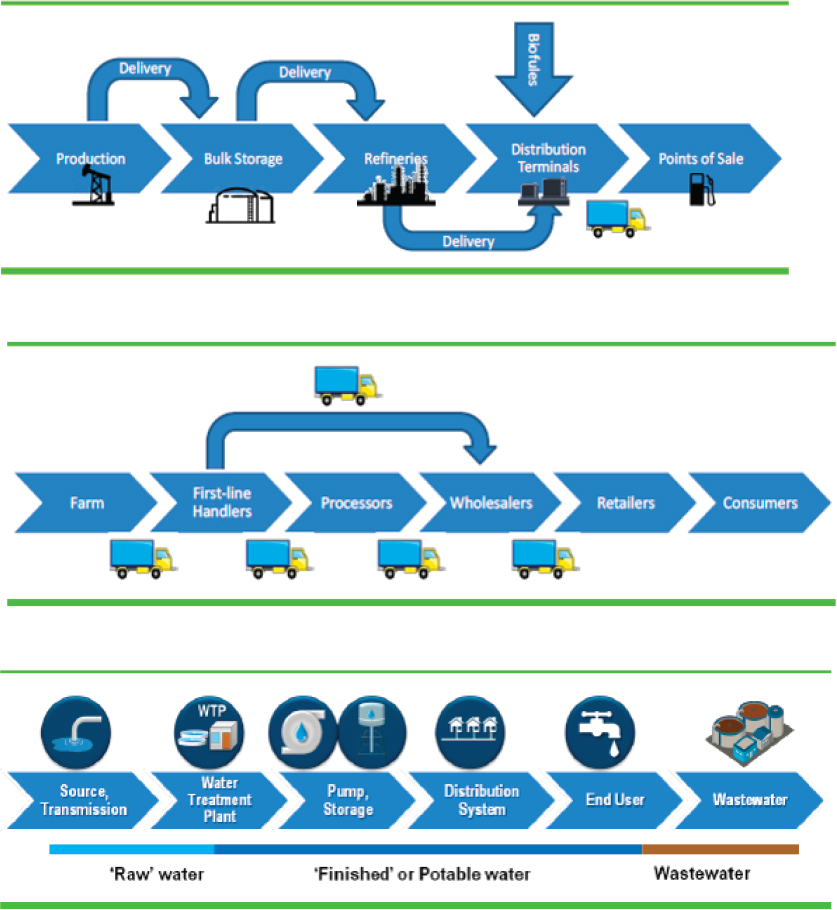Appendix B
Overview of the CNA Analyses
The information gathering and analyses carried out by the CNA investigators is presented in the following references, also shared directly online at https://www.cna.org/research/ hurricane-supply-chain.
- Palin, P. J. 2018. Learning from H.I.M. (Harvey, Irma, Maria): Preliminary impressions for supply chain resilience. Homeland Security Affairs 14, Article 7. https://www.hsaj.org/articles/14598 (accessed November 21, 2019)
- Palin, P. J., L. S. Hanson, D. Barton, and A. Frohwein. 2018. Supply Chains and the 2017 Hurricane Season: A collection of case studies about Hurricanes Harvey, Irma, and Maria and their impact on supply chain resilience. Arlington, VA: CNA Analysis and Solutions
This work includes a detailed time line of the three hurricanes and their impacts in each of the main study areas, and a helpful overview of the basic supply chain dynamics for motor fuels, public water supply, and retail food (see Figure B.1). Based on investigations and on-site field research in Texas (Houston and the Coastal Bend), Florida (Jacksonville, Orlando, and South Florida), Puerto Rico (San Juan, Comerio, and Yabucoa), and the U.S. Virgin Islands (Saint Croix), the CNA team then presents a series of case studies about key supply chains of interest (summarized in Table B.1). These include:
- Case study 1, “Retail Resilience in Puerto Rico,” which examines the surprising resilience of the retail sector supplying food and fuel after Hurricane Maria.
- Case study 2, “Static on the Relief Channel,” which investigates how food deliveries from the federal government created both real and perceived impacts on the retail food sector in Puerto Rico and caused spillover effects into other supply chains.
- Case study 3, “Resupplying Metro Miami,” which examines Florida during Hurricane Irma, specifically, how fuel availability affected the transportation of food and other goods before, during, and after the hurricane.

SOURCE: Palin et al., 2018.
TABLE B.1 CNA Case Studies’ Subjects, Hurricanes Involved, Affected Areas, and Supply Chains of Concern
| Case Study Subject | Storm | Area | Supply Chains |
|---|---|---|---|
| Retail resilience | Maria | Puerto Rico | Food, fuel |
| Static on the relief channel | Maria | Puerto Rico | Food |
| Resupplying metro Miami | Irma | Florida | Fuel, food |
| Water networks after Harvey | Harvey | Texas | Water |
| Box: Irma and the Florida Keys | Irma | Florida Keys | Water |
| Constraints in optimized networks | |||
| Retail cross-dock | Irma | Florida | Food |
| Fuel networks | Irma | Florida | Fuel |
| Ports | Irma, Maria | Puerto Rico | General |
| Manufacturing of intravenous fluids | Irma, Maria | Puerto Rico | Medical |
- Case study 4, “Harvey Turns On (and Then Turns Off) the Tap,” which looks at how Hurricane Harvey affected water suppliers, and what hindered and helped their ability to recover.
- Case study 5, “Constraints in Optimized Networks,” which looks at bottlenecks in supply chains in a variety of forms, using four examples from Florida and Puerto Rico.
An additional Case study 6, “External Factors—Debris and Donations,” is online only (not in the full report) and examines how specific local factors (post-storm debris management, unrequested donations) can influence the resilience of lifeline supply chains by changing the response environment and imposing burdens on local resources needed for disaster response.
This page intentionally left blank.




